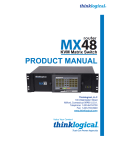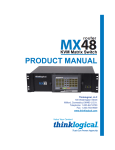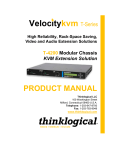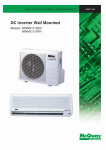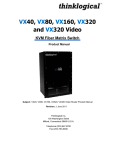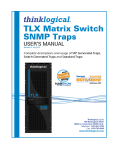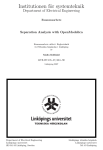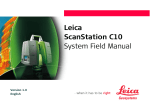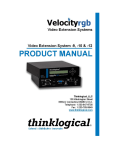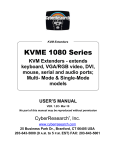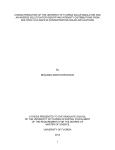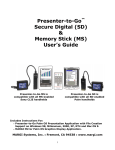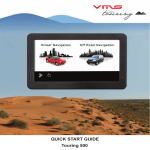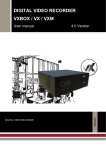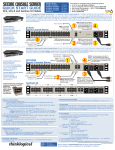Download VX640 Modules - Thinklogical
Transcript
Copyright Notice Copyright © 2012. All rights reserved. Printed in the U.S.A. Thinklogical® LLC 100 Washington Street Milford, Connecticut 06460 U.S.A. Telephone: 1-203-647-8700 All trademarks and service marks are property of their respective owners. Subject: VX640 KVM Matrix Switch Product Manual Revision: A, May 2012 Revision B i July 2012 Table of Contents PREFACE............................................................................................................................................... iv About this Product Manual............................................................................................................... iv Conventions Used in this Manual .................................................................................................... iv Introduction ............................................................................................................................................ 1 The Logical Solution .......................................................................................................................... 1 Laser Information ............................................................................................................................... 1 Theory of Operation ........................................................................................................................... 2 MRTS Technology ........................................................................................................................... 2 System Features ................................................................................................................................ 3 General System Features ................................................................................................................ 3 Technical Specifications ................................................................................................................... 4 PART 1: HARDWARE ............................................................................................................................. 5 Contents ............................................................................................................................................. 5 VX640 Modules................................................................................................................................... 6 Interconnect Module ......................................................................................................................... 7 Status LEDs ...................................................................................................................................................................7 Switch Card Modules ....................................................................................................................... 8 Power Supplies .............................................................................................................................. 10 Fan Tray......................................................................................................................................... 11 Controller Card ............................................................................................................................... 12 Pluggable SFP+ ............................................................................................................................. 13 Input/Output Cards ......................................................................................................................... 14 PART 2: SET-UP AND INSTALLATION ............................................................................................... 17 Set-Up ............................................................................................................................................... 17 Connecting to the VX640 ................................................................................................................. 18 Fiber Optic Cable ........................................................................................................................... 18 Requirements ...............................................................................................................................................................18 Handling Fiber Optic Cable ........................................................................................................................................18 Installing Fiber into Input/Output Cards ....................................................................................................................18 Removing Fiber from Input/Output Cards ................................................................................................................18 Connecting to Thinklogical® Velocity Extenders ............................................................................. 19 Connecting to the Receiver ........................................................................................................................................19 Connecting to the Transmitter ...................................................................................................................................19 Connecting to a Control Computer ................................................................................................. 20 Firmware ........................................................................................................................................ 20 On Screen Display (OSD) - Firmware Option .........................................................................................................20 Upgrades ......................................................................................................................................................................20 Order of Installation Events ............................................................................................................ 20 How to Install/Replace Modules ...................................................................................................... 20 How to Install or Replace Input/Output Cards ................................................................................. 20 How to Install or Replace an Interconnect Module .......................................................................... 21 How to Install or Replace a Switch Card......................................................................................... 22 How to Install or Replace a Controller Card .................................................................................... 23 How to Replace a Fan Tray ............................................................................................................ 23 How to Replace a Power Supply .................................................................................................... 24 Revision B ii July 2012 PART 3: REGULATORY & SAFETY REQUIREMENTS ....................................................................... 25 Symbols found on the product ....................................................................................................... 25 Regulatory Compliance ................................................................................................................... 25 North America ................................................................................................................................ 25 Australia & New Zealand ................................................................................................................ 25 European Union ............................................................................................................................. 25 Declaration of Conformity ...........................................................................................................................................25 Standards with Which Our Products Comply ................................................................................ 26 Supplementary Information............................................................................................................. 26 Product Serial Number ................................................................................................................... 27 Connection to the Product .............................................................................................................. 27 PART 4: THINKLOGICAL® SUPPORT ................................................................................................. 28 Customer Support ........................................................................................................................... 28 Website .......................................................................................................................................... 28 Email .............................................................................................................................................. 28 Telephone ...................................................................................................................................... 28 Fax ................................................................................................................................................. 29 Product Support............................................................................................................................... 29 Warranty ........................................................................................................................................ 29 Return Authorization....................................................................................................................... 29 Our Address ................................................................................................................................... 30 APPENDIX A: ORDERING INFORMATION .......................................................................................... 31 APPENDIX B: QUICK START GUIDES ................................................................................................ 32 APPENDIX C: X4 CONFIGURATOR SOFTWARE ............................................................................... 34 Revision B iii July 2012 PREFACE About this Product Manual This product manual is divided into four sections, for Hardware, Software, Safety Requirements and Product Support. These are sub-divided to help you easily find the topics and procedures you are looking for. This manual also contains Appendices. Part 1 – Hardware: This section of the manual contains all the information and instructions on how to assemble your equipment. Part 2 – Set-Up and Installation: This section of the manual contains all the requirements and procedures necessary to connect and install your equipment. Part 3 – Safety & Regulatory Requirements: Thinklogical® strongly recommends that you read this section of the manual prior to starting the hardware assembly. Part 4 – Thinklogical® Support: Thinklogical® provides the best customer support available. If you have any questions or need to contact the company, please refer to this section of the manual. Conventions Used in this Manual Throughout this manual you will notice certain conventions that bring your attention to important information. These are Notes and Warnings. Examples are shown below. Note: Important Notes appear in blue text preceded by a yellow exclamation point symbol, like this. A note is meant to call the reader’s attention to helpful information at a point in the text that is relevant to the subject being discussed. Warning! All Warnings appear in red text, followed by blue text, and preceded by a red stop sign, like this. A warning is meant to call the reader’s attention to critical information at a point in the text that is relevant to the subject being discussed. BEFORE STARTING ANY PROCEDURE, IT IS RECOMMENDED THAT YOU READ THE INSTRUCTIONS THOROUGHLY! Revision B iv July 2012 Introduction The Logical Solution The VX640 is a high performance modular router and non-blocking matrix switch for complete, end-toend routing of video and peripheral signals over multi-mode or single-mode fiber optic cable. This highly reliable and resilient router is expandable from 20x20 up to 640x640, which allows for flexible deployment configurations. In addition, the VX640 series provides mission critical dependability and unrivalled signal integrity. Being protocol agnostic, the switch supports DVI, SDI, HD-SDI, Dual-link DVI, Dual-link SDI, USB 1.1, USB 2.0 and audio. The VX640 Router from Thinklogical® includes: (2) Redundant, Current Sharing Power Supply Modules for the Upper Cage (2) Redundant, Current Sharing Power Supply Modules for the Lower Cage (1) Fan Tray Module (includes three fans) (1) Primary Controller Card (8) Switch Cards (1) Interconnect Card Optional Modules (Spares): VX640 Router Data Input/Output Card, 20 Ports, SFP+ VX640 Router Fail-Over Controller Card VX640 Router Switch Card VX640 Router Fan Tray VX640 Router Power Module The VX640 Router is available with LC-type fiber connectors. See Appendix A for the complete line of the Thinklogical® VX640 Router. Laser Information The VX640 is designed and identified as Class 1 LASER products. CLASS 1 LASERS do not require any special precautions under conditions of normal use. Revision B 1 July 2012 Theory of Operation MRTS Technology Thinklogical® VX640 KVM Matrix Swtich is used together as a system with our Thinklogical Velocity Extenders utilizing breakthrough, patent-pending technology for transmission and reception of DVI, keyboard, mouse, and high-speed data peripherals. This technology, known as Multi Rate Transmission System (MRTS), provides end-to-end data transmission with unparalleled performance. This new, unique optic platform enables multiple data streams to be transmitted long distances over single or multiple fibers with complete reconstruction of the data clock at the destination end point. The result is perfect synchronization with each transmitted stream. All new products are designated with our Powered by MRTS Technology “Powered by MRTS Technology” logo. MRTS is a highly reliable technology and delivers powerful benefits to our customers when combined with our new SFP+ optics. The new MRTS Technology has the ability to transport every frame of a 1920 x 1200 @ 60Hz (or higher) video stream with no compression, along with all desktop peripherals (keyboard, mouse, etc., including 480Mbps USB 2.0) with no perceptible latency. Moreover, these signals can be transmitted distances from just a few meters up to 40 kilometers over single-mode or multi-mode fibers. MRTS allows for traditional AV implementations and video routing to be incorporated into the same switch fabric, providing greater value, flexibility, performance and security. Additional unique capabilities include the ability to support 6.25Gbps bandwidth per stream, between 50% and 100% higher than our nearest competitors (typically 1.485Gbps to 3.2Gbps). This is significant because a single DVI stream requires a 5.4Gbps data rate to accommodate the 165MHz of video data. Our competitor’s lower bandwidth capability is generally manifested in either dropped frames or lower resolution associated with compressing schemes. Not so with MRTS Technology. Figure 1: MRTS Technology Revision B 2 July 2012 System Features General System Features Each VX640 includes the following features: 640 Duplex In and Out Fiber Ports for 640 x 640 Non-Blocking Matrix Switching Fiber Optic Non-Blocking Matrix Router Each Video Connection Supports 6.22 Gbps Single-Mode and Multi-Mode Fiber Optic Capability Coaxial SFP Modules for SDI/HD and SDI/3G Video Redundant, Hot-Swappable and Current Sharing Power Supply Modules Hot Swappable, 20 Port Scalability for In and Out Cards Hot Swappable SFP+ Optical Port Connections Hot Swappable Fan Tray with Annunciator Port (for Alarms) Hot Swappable Fail-Over Controller Card (optional) External Control CPU Rack Computer, 1 or 2 RU SNMP (2C) Control Protocol Control/Administration X4 Configurator GUI Included Multi-casting and Macros Supported Protocol Agnostic Compatible with all Thinklogical’s® Video and KVM Extension Systems Compatible with all Thinklogical’s® SDI Xtreme 3G+ Extension Systems Figure 2: VX640 Router KVM Matrix Switch Revision B 3 July 2012 Technical Specifications Dimensions: Rack Size/Width: EIA 19" (482.6 mm) Height: 26 RU- 45.47” (1154.9 mm) Depth: 16.07” (408.2) Depth with cable management: 20.36" (517.3 mm) Chassis (Tolerance: ± .039"; .1000 mm) Weight: 132 lbs (59.87 kg) Shipping Weight: 160 lbs (72.57 kg) Power Consumption: 1700 watts fully loaded Ports 20 x 20 minimum / 640 x 640 maximum Maximum DC: 1A at 30VDC Alarm Relay Maximum AC: 0.3A at 125VAC Contacts Contact resistance maximum: 100 mΩ Operating Temp 0° to 50°C (32° to 122 °F), 5% to 95% RH, non-condensing and Humidity Power AC Input: 100-240VAC, 47-63 Hz Requirements Universal AC Power Supply Compliance Approvals for US, Canada, and European Union Warranty Revision B 12 months from date of shipment. Extended warranties available. 4 July 2012 PART 1: HARDWARE Contents When you receive your Thinklogical® VX640 KVM Matrix Switch, you should find the following items: VX640 Chassis (includes Power Module, Fan Tray, (8) Switch Cards, Interconnect Card and Controller Card) Power Cord – Qty 4 – PWR-000056-R (International connections may differ) CAT5 Cable Assembly, 15 Feet – CBL000001-015FR Product Manual CD Product Quick Start Guide Chassis Options (Spares): Fail-Over Controller Card – VXM-000025 Spare Switch Card – VXM-000026 Spare Fan Tray – VXM-000027 Spare Power Module – VXM-000028 Data Input/Output Card, 20 Ports – VXM-DI0R20 The VX640 KVM Matrix Switch ships configured to customer specifications. All physical connections to the product use industry-standard connectors. Figure 3: VX640 Spare Modules (l to r: Controller Card, Fan Tray, Power Module, Data Input/Output Card) Revision B 5 July 2012 VX640 Modules The inspired modular approach of the VX640 allows for all critical system components including switch cards, power supplies, cooling fans and pluggable optics (SFP+) to be hot-swappable, thus minimizing business impact in the unlikely event that a component should fail. (The Interconnect Card is modular, yet not hot-swappable. It can be replaced easily in the field, however, the VX640 system would need to be shut down for this replacement.) Figure 4: Detailed Front View of VX640 Warning! KEEP FRONT DOOR CLOSED WHEN NOT IN USE. The VX640 Front Door contains air-flow baffles that are integral to the router’s cooling system. Do not leave the front door off the chassis for an extended length of time if the unit is running. Keeping the front door open for an extended period of time will lead to a malfunction of the VX640. Revision B 6 July 2012 Interconnect Module The Interconnect Module connects the Upper Card Cage to the Lower Card Cage. It is located within the chassis of the VX640. The Interconnect Card contains no active components, yet it does have LED indicators and the DIP Switch. This module can be accessed through the front of the router. See the DIP Switch Instructional Guide in Appendix B, Quickstart Guides for detailed instructions on how to access the Interconnect Module and set the DIP Switch. Status LEDs The VX640 router was designed with status LEDs located on the front of the unit. These LEDs give a visual indication of the System Power (12V) and the Controller Power (3.3V) in both the Upper and Lower Card Cages. Figure 5: VX640 Front Panel Status LEDs Revision B 7 July 2012 Switch Card Modules The VX640 contains 8 Switch Cards which are located behind the Front Door. The Switch cards are labeled from right (Card 1) to left (Card 8). These cards contain the crosspoint fabric of the router; they allow for 8 possible paths for making connections. In the event that a Switch Card may fail, some connections will not be allowed. The hot-swappable feature allows for easy replacement of a Switch Card without the need to shut down the VX Router. Figure 6: VX640 Switch Cards Revision B 8 July 2012 Figure 7: Detailed Rear Panel View of VX640 Warning! The Primary Power Supplies (Primary Power Supply for the Upper Cage and Primary Power Supply for the Lower Cage) MUST be powered up within 30 seconds of each other in order to prevent malfunction of the VX640. Revision B 9 July 2012 Power Supplies The dual redundant power supplies ensure continuous, uninterrupted power. The supplies are current sharing which means the supplies equally share the load. If a power supply were to fail, a single power supply can withstand the entire current load of the VX Router system. Although the VX Router functions properly with one Power Module, it is recommended that both modules be used, preferably connected to two independent power sources (for redundancy). Additionally, the hot-swappable feature allows for easy replacement of a module (in case of failure) without interrupting the VX Routers system functionality. When powering up the VX640, the Primary Power Supplies (Primary Power Supply for the Upper Cage and Primary Power Supply for the Lower Cage) MUST be turned on within 30 seconds of each other in order to prevent malfunction of the VX640. Figure 8: VX640 Power Supply Modules Warning! The Primary Power Supplies (Primary Power Supply for the Upper Cage and Primary Power Supply for the Lower Cage) MUST be powered up within 30 seconds of each other in order to prevent malfunction of the VX640. Revision B 10 July 2012 Fan Tray The VX640 Router uses 3 DC fans all located conveniently in one modular fan tray. The tray is designed to move air horizontally through the enclosure. This hot-swappable fan tray allows for easy replacement of the module (in case of failure) without interrupting the system functionality. Any 2 DC fans will adequately cool either system. Warning! KEEP FRONT DOOR CLOSED WHEN NOT IN USE. The VX640 Front Door contains air-flow baffles that are integral to the router’s cooling system. Do not leave the front door off the chassis for an extended length of time if the unit is running. Keeping the front door open for an extended period of time will lead to a malfunction of the VX640. The Fan Tray is also equipped with an Annunciator Port for the use of alarms. The system alarms can be configured to trigger an external control system or generate e-mail notifications. Figure 9: VX640 Fan Tray with Alarm Annunciator The VX640 Critical Hardware Alarms are as follows: Figure 10: Alarm Descriptions and Drawing for the VX640 Revision B 11 July 2012 Controller Card The hot-swappable Controller Card connects the Router to an External CPU. The serial port can also be used for 3rd party controller integration (such as Crestron, AMX or home-spun interfaces). Also, the X4 Configurator Software (Appendix C) can be used to control the Router via the LAN port. Figure 11: VX640 Controller Card The External Control CPU running X4 Configurator Software must meet the following minimum requirements: RedHat EL5.3 installed (or CentOS 5.3) (32-bit, not 64-bit, version) Windows XP, Windows 7 Mac OS X 1 Gig RAM 1 DVD drive VGA and/or DVI video port USB or PS2 Keyboard / Mouse 2 network ports (Port 1 - system maintenance, Port 2 - dedicated to VX640 20 Gig (minimum) hard drive Revision B 12 July 2012 If the VX640 KVM Matrix Switch is to be controlled via ethernet, it will require a static IP address. This value can be set via the DIP switch. See the DIP Switch Instructional Guide in Appendix B, Quickstart Guides for detailed instructions on how to access and set the DIP Switch. Factory default setting will be 192.168.13.15. 0 0 0 0 1 1 0 0 DIP Switch 8 0 0 0 0 0 0 0 0 0 0 0 0 0 0 0 0 7 0 0 0 0 0 0 0 0 0 0 0 0 0 0 0 0 6 0 0 0 0 0 0 0 0 0 0 0 0 0 0 0 0 5 0 0 0 0 0 0 0 0 0 0 0 0 0 0 0 0 4 0 0 0 0 0 0 0 0 1 1 1 1 1 1 1 1 3 0 0 0 0 1 1 1 1 0 0 0 0 1 1 1 1 2 0 0 1 1 0 0 1 1 0 0 1 1 0 0 1 1 1 0 1 0 1 0 1 0 1 0 1 0 1 0 1 0 1 Primary Controller IP Addresses Back-up Controller IP Address 192.168.13.15 & 192.168.13.115 192.168.13.16 192.168.13.18 192.168.13.20 192.168.13.22 192.168.13.24 192.168.13.26 192.168.13.28 192.168.13.30 192.168.13.32 192.168.13.34 192.168.13.36 192.168.13.38 192.168.13.40 192.168.13.42 192.168.13.44 192.168.13.46 192.168.13.17 & 192.168.13.117 192.168.13.19 & 192.168.13.119 192.168.13.21 & 192.168.13.121 192.168.13.23 & 192.168.13.123 192.168.13.25 & 192.168.13.125 192.168.13.27 & 192.168.13.127 192.168.13.29 & 192.168.13.129 192.168.13.31 & 192.168.13.131 192.168.13.33 & 192.168.13.133 192.168.13.35 & 192.168.13.135 192.168.13.37 & 192.168.13.137 192.168.13.39 & 192.168.13.139 192.168.13.41 & 192.168.13.141 192.168.13.43 & 192.168.13.143 192.168.13.45 & 192.168.13.145 Figure 12: VX640 DIP Switch Setting The simplest network connection is an isolated network with only the VX640, the control server, and any control clients using static IP addresses. The VX640 can be set to any of the above settings. The control server must be at 192.168.13.9, and the control clients could then be set to any other addresses in the 192.168.13.X family. If static IP addresses for the control server and its clients are not possible, then the control server will require two (2) network interfaces with one interface set to the static address 192.168.13.9 and dedicated to the VX640 KVM Matrix Switch(s) while the other network interface can be configured as required by the facility's network administrator. A Back-Up Controller Card is optional to ensure uninterrupted functionality if the Primary Controller Card should fail or need to be replaced. The Primary Controller Card should always be in the upper controller slot. The back-up card must have a LAN connection that allows it to communicate with both the Primary Controller and a server having an IP address of 192.168.13.9. Without this interface the back-up controller will never take control of the router. Pluggable SFP+ The SFP+ Optical Module is an 8Gbs Short-Wavelength Transceiver designed for use in bi-directional Fiber Optic Channel links. The modules are hot-pluggable and operate with 3.3VDC. Each Input and Output card contains rows of SFP+ modules that serve as the fiber-optic couplers for the fiber cables to and from the Thinklogical TX and RX Extenders. Individual cards can be removed for ease of access to the SFP+ modules. Always use dust caps to protect against damage when a fiber optic connector is not attached to its coupling device (fiber optic equipment, bulkheads, etc.) Revision B 13 July 2012 Dust Plug Figure 13: SFP+ Module; it is good practice to install dust plugs in unused SFP+s Each VX640 I/O card has 20 SFP+s, each mounted within a grounded metal enclosure. Each SFP+ module is locked into its enclosure with a built-in latch handle that can be opened for removal or locked for installation. Figure 14a: SFP+ latch closed Figure 14b: SFP+ latch open The latch handle spans the two LC ports and arrows printed on the handle indicate which port is an INPUT ( ) and which is an OUTPUT ( ). Input/Output Cards The hot-swappable Input/Output (I/O) cards provide excellent in-service expansion capabilities in convenient sets of 20 ports per I/O card, thus allowing re-configuration without interrupting signal processing. Each I/O card consists of one Transmit (T) and one Receive (R) optic per port. I/O Cards are available with LC-type fiber connectors and can be assembled with Single-mode or Multi-mode optics (SFP+). Each individual I/O Card lists the ports as 1 through 20 on the VX640. An LED located on each I/O card indicates when power is ON to that card. Figure 15: Input/Output Port Numbering on the VX640 Revision B 14 July 2012 At the bottom of the Lower Cage and the bottom of the Upper Cage, the port numbers for each slot are listed (all numbering is bottom to top, left to right (see Figure 7). The VX640 Router configuration can have a minimum of one I/O Card (20 x 20) and a maximum of 32 I/O Cards. Each VX640 I/O card contains 20 ports, so that when fully configured, the VX640 will contain 16 I/O cards in the Upper Card Cage and 16 I/O cards in the Lower Card Cage. The 32 I/O cards provide a total of 640 Optical Input/Output connections (SFP+ T/R) described as Ports 1-640. The VX640 switching matrix connects any port optical output (SFP+ T) to any port optical input (SFP+ R). Figure 16: Concept of VX 640 Upper and Lower Card Cage Flows Revision B 15 July 2012 Figure 17: The VX 640 Upper Card Cage/Lower Card Cage and Controller Card Revision B 16 July 2012 PART 2: SET-UP AND INSTALLATION Set-Up All physical connections to the product use industry-standard connectors. Non-supplied cables that may be needed are commercially available. All connections are found on the rear of the unit. Note: Insure that all thumb screws are finger tight so that all the modules are properly held in the chassis. 1. Carefully remove the VX640 KVM Matrix Switch from its shipping container. Inspect the router to make certain that no damage occurred during shipment. 2. All of the I/O cards are installed at the factory to meet the configuration. Insure that the I/O cards are properly seated in the unit. All of the I/O cards have thumb screw retainers. 3. After checking the I/O cards, go to the top of the unit. There are 4 power supplies located in the top part of the chassis. Verify that the power supplies are secure in the chassis. 4. Located below the power modules is a fan tray. The fan tray has thumb screws holding it into the chassis. Verify that the fan tray is secure. Cooling is accomplished by the fan trays, fans in the power supply units and air baffles in the front door. Air is forced into the chassis from the fan tray. This cools the vertically mounted I/O cards, the integrated circuits on the Switch Cards and the backplane, as well as removing any heat generated by the power modules. Note: If mounting the chassis in a rack, insure that none of the fans or the front door have restricted air flow. 5. The temperature in the chassis is monitored in several locations. The power supply has an internal temperature sensor that is monitored constantly for any conditions that may indicate a problem. Other temperature sensors are mounted in the fan trays, on the Controller card(s), on the I/O cards, and on the Switch Cards. Note: If any of these sensors detect an over temperature condition, power will be removed from all sensitive components and the system will shut down. 6. As a further safeguard, all fan speeds are monitored and any fan speed that does not meet specification will cause the unit to set alarm condition. Warning! Do not remove the front door for more than a few minutes when the unit is powered. The Switch Card integrated circuits will overheat when operating without the front door attached. Revision B 17 July 2012 Note: All of these conditions send out notifications prior to shut down. For a detailed list of the alarm descriptions, see Figure 10: Alarm Descriptions and Drawing for the VX640. 7. When the VX Router has been inspected and found to be in good condition, the installation process can begin. Connecting to the VX640 Fiber Optic Cable Requirements Thinklogical® recommends SX+ Laser Enhanced (50µm) fiber for your VX640 KVM Matrix Switch and Velocity Extension System. Multi-mode fiber has the ability to extend up to a maximum of 1000m, where Single-mode fiber has the ability to extend distances beyond 1000m. Handling Fiber Optic Cable Unlike copper cabling, fiber optic cable requires special handling. A small speck of dust or a scratch to the ferrule tip (the end of the connector) can attenuate the optical signal so that it becomes unusable. Warning! The ends of the connectors (the ferrule) should never come in contact with any foreign object, including fingertips. Warning! Minimum bend radius must be 1.5”. Be careful not to pinch the fiber when using ties. Installing Fiber into Input/Output Cards Step 1: Grasp the LC connector of the fiber optic cable by the sides and remove the dust cap. Step 2: Open the LC retractable and carefully insert the fiber connector into the SFP+ port until it locks into place. Removing Fiber from Input/Output Cards Step 1: The LC connector has a locking feature that can be released by depressing the latch-release tab located on the side of the connector. With the tab depressed, slowly remove the cable by pulling the connector straight out of the SFP+ port. Step 2: Immediately install a dust cap on the ferrule to protect the fiber tip. Revision B 18 July 2012 Connecting to Thinklogical® Velocity Extenders The VX640 is designed to work with any Thinklogical® product designed with the MRTS technology (e.g. Velocity Extenders). The VX640 and Velocity Extenders are a new, unique class of cost-effective matrix switching and KVM extension designed for a variety of high-performance computing environments. Comprised of a fiber-in, fiber-out matrix switch and a fiber-optic KVM extender (with a transmitter and receiver), this complete system provides transparent and secure routing, switching and extension of video and high-speed data peripherals to remote destinations with ease. Connecting to the Receiver The Velocity Receiver serves as the Destination (desktops, theaters, conference rooms, editing suites, control consoles, video walls, etc). Depending on your configuration, your KMASS devices (audio, keyboard, mouse, etc) are first connected to the Receiver using standard cables. Power can then be supplied to the unit. The Receiver then connects to the VX640 Receiver ports using fiber (Multi-mode fiber for distances up to 1000m; Single-mode fiber for distances beyond 1000m). Connecting to the Transmitter The Transmitter serves as the Source (computer and video entities). Depending on your configuration, your local KMASS devices (keyboard, mouse, etc) are first connected. The video sources (e.g. computers) are then connected followed by any local video devices. Power can then be supplied to the unit. The Transmitter connects to the VX640 Transmitter ports using fiber (Multi-mode fiber for distances up to 1000m; Single-mode fiber for distances beyond 1000m). Figure 18: Connecting Thinklogical® VelocityKVM-24 Extenders to the VX640 Revision B 19 July 2012 Connecting to a Control Computer Note: The Control Computer is supplied separately from the VX Router. The VX640 is controlled via a dedicated external Control module. This allows for customization as well as ease of control and administration with access provided via a network connection (browser). Firmware On Screen Display (OSD) - Firmware Option The X4 Configurator can be accessed and controlled via an OSD (on-screen display) technology. The X4 Configurator software can be installed on a designated OOB (out-of-band) PC which users can access from their workstation. A preconfigured hot-key sequence will deliver the X4 Configurator GUI straight to the user’s desktop monitor. The user can then select the defined sources and destinations that they wish to connect. While a user is making the connections, they have exclusive use of the OOB PC. Once they have completed their connections the OOB PC becomes available for the next user. The OOB PC that has the X4 Configurator loaded on it has a built in time out function, therefore the PC cannot be taken out of service for an extended period of time. The time outs can be set in increments of one second. Typical time outs are in the order of 10 seconds. Upgrades Firmware upgrades are available through Thinklogical®. For technical assistance, please call us at 1-203-647-8700. Order of Installation Events Please refer to the Quick Start Guide included with your products for detailed instructions. The Quick Start Guide is also available in Appendix B. How to Install/Replace Modules How to Install or Replace Input/Output Cards Note: A shutdown is not required prior to installing/replacing Input/Output Cards. Step 1 Turn the two thumbscrews counterclockwise until they disengage from the chassis. Pull the card out using both handles. Warning! Do not pull on the thumbscrews when removing the module – damage may occur! OR If a blank panel is present, remove the blank panel from the desired location using the thumbscrews. Revision B 20 July 2012 Step 2 Place the new module upright so that the POWER LED is on the top. Grasp the module by the handles or by the outer edge of the aluminum housing. The card should slide freely until it reaches the backplane connector. At this point, use just enough force to firmly engage the card with the mating connector. Warning! If the module does not slide into the connector, do not force it! Damage may occur. Remove the card and start over. Step 3 Once the module is completely seated, hand-tighten the thumbscrews. Warning! Do not tighten the thumbscrews with a screwdriver. How to Install or Replace an Interconnect Module Note: Replacing the Interconnect Module will interrupt service. To replace the Interconnect Module, the front door and front panel must first be removed. Step 1 Turn both front door latches one quarter turn clockwise (arrow on knob pointing up) to release the door. Step 2 Holding the door steady with one hand, pull down the upper spring-loaded hinge release and pull the upper portion of the door outward until the latch clears the mounting hole. The door can now be removed and set aside. Warning! KEEP FRONT DOOR CLOSED WHEN NOT IN USE. The VX640 Front Door contains air-flow baffles that are integral to the router’s cooling system. Do not leave the front door off the chassis for an extended length of time if the unit is running. Keeping the front door open for an extended period of time will lead to a malfunction of the VX640. Step 3 There are two thumb screws holding the front panel to the chassis. Loosen the thumb screws, remove the front panel and set it aside. Step 4 There are two thumbscrews on the Interconnect Module; turn the thumbscrews counterclockwise until they disengage from the chassis. Pull the Interconnect Module out using both black ejector handles. Revision B 21 July 2012 Step 5 Place the new module upright so that the four Status LEDs are at the bottom. Grasp the module by the handles or by the outer edge of the aluminum housing. The card should slide freely until it reaches the backplane connector. At this point, use just enough force to firmly engage the card with the mating connector. Warning! If the module does not slide into the connector, do not force it! Damage may occur. Remove the card and start over. Step 6 Once the module is completely seated, hand-tighten the thumbscrews. Warning! Do not tighten the thumbscrews with a screwdriver. Step 7 Replace the front panel that was removed in Step 3. Step 8 Replace the front door that was removed in Steps 1 and 2. For more detailed instructions on removing the front door and front panel, see the DIP Switch Instructional Guide in Appendix B, Quickstart Guides. How to Install or Replace a Switch Card Note: The Switch Cards are hot-swappable; the VX640 system does not need to be shutdown to replace. Step 1 Turn the thumbscrews counterclockwise until they disengage from the chassis. Pull the Switch Card out using both black ejector handles. Step 2 Place the new module upright so that the integrated circuitry/components are on the right side of the card. Grasp the module by the handles or by the outer edge of the aluminum housing. The card should slide freely until it reaches the backplane connector. At this point, use just enough force to firmly engage the card with the mating connector. Warning! If the module does not slide into the connector, do not force it! Damage may occur. Remove the card and start over. Revision B 22 July 2012 Step 3 Once the module is completely seated, hand-tighten the thumbscrews. Warning! Do not tighten the thumbscrews with a screwdriver. How to Install or Replace a Controller Card Note: When using a single Controller, the top Controller slot is always Primary. Note: Replacing the Controller Card will interrupt service if a Fail-over Controller Card is not installed. Step 1 Turn the thumbscrews counterclockwise until they disengage from the chassis. Pull the Controller Card out using both black handles. Step 2 Place the new module upright so that the ACTIVE LED is on the top. Grasp the module by the handles or by the outer edge of the aluminum housing. The card should slide freely until it reaches the backplane connector. At this point, use just enough force to firmly engage the card with the mating connector. Warning! If the module does not slide into the connector, do not force it! Damage may occur. Remove the card and start over. Step 3 Once the module is completely seated, hand-tighten the thumbscrews. Warning! Do not tighten the thumbscrews with a screwdriver. How to Replace a Fan Tray The VX640 uses three DC fans to move air horizontally through the enclosure. Be sure not to block the air vents on the front and rear of the unit, and leave at least 2” of space on both sides. Note: Be sure to leave adequate ventilation space on both sides of the units (2” minimum), especially if units (e.g. Extenders) are being stacked above or below the VX640 KVM Matrix Switch. Note: No shutdown is required prior to replacing the Fan Tray. Revision B 23 July 2012 Step 1 Turn the four thumbscrews counterclockwise until they disengage from the chassis. Step 2 Pull the Fan Tray module out using both black handles. Step 3 Place the new module so that the aluminum housing is on the bottom. Hold the new Fan Tray by the black handles and slide the aluminum housing into the black card guides. Warning! Do not operate the unit without a Fan Tray installed for greater than 10 minutes. Step 4 Hand-tighten the thumbscrews. Warning! Do not tighten the thumbscrews with a screwdriver. How to Replace a Power Supply Warning! Disconnect the power cord before proceeding! Note: If TWO primary power supplies are installed: shutdown IS required. If TWO primary power supplies and TWO back-up power supplies are installed, shutdown IS NOT required. The Power Modules are universal input 120-240VAC 50-60Hz. Use the proper power cord for your region (supplied with the unit). Although the router functions properly with two Primary Power Modules, it is recommended that all four Modules (two Primary, two Back-up) preferably be connected to two independent power sources (for redundancy). Step 1 Grasp the black handle with one hand. Step 2 Slide the green tab to the left with the other hand. Step 3 Pull the Power Module out of the chassis. Step 4 Insert the new Power Module into the chassis and slide it in until it reaches the backplane connector. The module should slide freely until it reaches the backplane connector. At this point, use just enough force to firmly engage the card with the mating connector. Warning! If the module does not slide into the connector, do not force it! Damage may occur. Remove the module and start over. Revision B 24 July 2012 PART 3: REGULATORY & SAFETY REQUIREMENTS Symbols found on the product Markings and labels on the product follow industry-standard conventions. Regulatory markings found on the products comply with domestic and many international requirements. Regulatory Compliance Thinklogical®’s products are designed and made in the U.S.A. Products have been tested by a certified testing laboratory and found to be compliant with the following standards (both domestic USA and many international locations): North America Safety ANSI/UL60950-1: 1st Edition (2003) CAN/CSA C22.2 No. 60950-1-03 LASER Safety CDRH 21CFR 1040.10 Class 1 LASER Product Electromagnetic Interference FCC CFR47, Part 15, Class A Industry Canada ICES-003 Issue 2, Revision 1 Australia & New Zealand This is a Class A product. In a domestic environment this product may cause radio interference, in which case the user may be required to take adequate measures. European Union Declaration of Conformity Manufacturer’s Name & Address: Thinklogical® 100 Washington Street Milford, Connecticut 06460 USA Telephone 1-203-647-8700 These products comply with the requirements of the Low Voltage Directive 72/23/EEC and the EMC Directive 89/336/EEC. Revision B 25 July 2012 Standards with Which Our Products Comply Safety CENELEC EN 60950-1, 1st Edition (2001) LASER Safety IEC60825:2001 Parts 1 and 2 Class 1 LASER Product Electromagnetic Emissions EN55022: 1994 (IEC/CSPIR22: 1993) EN61000-3-2/A14: 2000 EN61000-3-3: 1994 Electromagnetic Immunity EN55024: 1998 Information Technology Equipment-Immunity Characteristics EN61000-4-2: 1995 Electro-Static Discharge Test EN61000-4-3: 1996 Radiated Immunity Field Test EN61000-4-4: 1995 Electrical Fast Transient Test EN61000-4-5: 1995 Power Supply Surge Test EN61000-4-6: 1996 Conducted Immunity Test EN61000-4-8: 1993 Magnetic Field Test EN61000-4-11: 1994 Voltage Dips & Interrupts Test Supplementary Information The following statements may be appropriate for certain geographical regions and might not apply to your location. This Class A digital apparatus meets all requirements of the Canadian Interference-Causing Equipment Regulations. Cet appareil numérique de la classe A respecte toutes les exigencies du Règlement sur le matérial brouilleur du Canada. Warning! This is a Class A product. In a domestic environment, this product may cause radio interference, in which case the user may be required to take corrective measures. Revision B 26 July 2012 Note: This equipment has been tested and found to comply with the limits for a Class A digital device, pursuant to part 15 of the FCC Rules. These limits are designed to provide reasonable protection against harmful interference when the equipment is operated in a commercial environment. This equipment generates, uses and can radiate radio frequency energy and, if not installed and used in accordance with the instruction manual, may cause harmful interference to radio communications in which case the user may be required to take adequate corrective measures at their own expense. Note: This Class A digital apparatus complies with Canadian ICES-003 and has been verified as being compliant within the Class A limits of the FCC Radio Frequency Device Rules (FCC Title 47, Part 15, Subpart B CLASS A), measured to CISPR 22: 1993 limits and methods of measurement of Radio Disturbance Characteristics of Information Technology Equipment. Note: The user may notice degraded audio performance in the presence of electromagnetic fields. Note: If using a keyboard that is noise susceptible, a ferrite ring on the keyboard cable may be needed to comply with Immunity Requirements Product Serial Number Thinklogical® products have a unique serial number, imprinted on an adhesive label that is fixed to the bottom of the chassis. The serial number includes a date-code. The format for the date-code is 2 digits for the month, 2 digits for the day and 2 digits for the year, plus two or three digits for a unique unit number. This serial number is also found on the original shipping carton. Connection to the Product Connections and installation hardware for our products use industry-standard devices and methods. All wiring connections to the customer equipment are designed to minimize proprietary or customized connectors and cabling. Power connections are made with regionally appropriate power cords and approved methods. Revision B 27 July 2012 PART 4: THINKLOGICAL® SUPPORT Customer Support Thank you for choosing a Thinklogical® product for your application. We appreciate your business and are dedicated to helping you successfully use our product. Thinklogical® is here to help you. Thinklogical® is an engineering company and you will receive the information you require directly from our most knowledgeable engineers. We believe that the first line of support is the design engineer that developed the product. Therefore, your questions will be handled promptly by our in-house engineers who are most familiar with your products. To contact Thinklogical®, use the following telephone numbers and internet-based methods. Website Check out our website for current product offerings, support information and general information about all of the products we offer. Our internet website offers product information on all current systems, including technical specification sheets and installation guides (for viewing online or for download), product diagrams showing physical connections and other information you might need. Internet: www.thinklogical.com Note: Most online documents are stored as Adobe Acrobat “PDF” files. If you do not have the Adobe Acrobat reader needed to view PDF files, visit www.adobe.com for a download. Email Thinklogical® is staffed Monday through Friday from 8:30am to 5:00pm, Eastern Time Zone. We will try to respond to your email inquiries promptly, use the following email addresses for your different needs: [email protected] – Information on Thinklogical® and our products. [email protected] – Sales Department - orders, questions or issues. [email protected] – Product support, technical issues or questions, product repairs and request for Return Authorization. Telephone Telephone Sales: Contact our expert sales staff via telephone in Milford, CT at 1-203-647-8700 or if in the continental US, you may use our toll-free number 1-800-291-3211. We are here Monday through Friday from 8:30am to 5:00pm, Eastern Time Zone. Ask for your representative’s direct dial phone number when you call. Revision B 28 July 2012 Telephone Product Support: Contact Product Support via telephone in Milford, CT at 1-203-647-8700. The support lines are manned Monday through Friday, 8:30am to 5:00pm, Eastern Time Zone. International Sales: Please contact our US sales staff in Milford, CT at 1-203-647-8700. We are here Monday through Friday, 8:30am to 5:00pm, Eastern Time Zone (same as New York City). If leaving a voice message please provide a “best time to call back” so we may reach you at your convenience. Our switchboard attendant will direct your call during regular business hours. We have an automated attendant answering our main telephone switchboard after regular business hours and holidays. You can leave voice messages for individuals at any time. Our Sales Representatives have direct numbers to speed up your next call to us. Fax Our company facsimile number is 1-203-783-9949. Please indicate the nature of the fax on your cover sheet and provide return contact information. Product Support Thinklogical’s® support personnel are available Monday through Friday from 8:30am to 5:00pm, Eastern Time Zone. If your application requires assistance at some time outside of our normal business hours, please contact us beforehand and we will do our best to make arrangements to help you with your Thinklogical® products. Warranty Thinklogical® warrants this product against defects in materials and workmanship for a period of one year from the date of delivery. Thinklogical® and its suppliers disclaim any and all other warranties. Note: Thinklogical® Inc. products carry a one year warranty, with longer term available at time of purchase on most products. Please refer to your product invoice for your products Warranty Terms & Conditions. Defect remedy shall be the repair or replacement of the product, provided that the defective product is returned to the authorized dealer within a year from the date of delivery. If you wish to return your device, contact the Thinklogical® authorized dealer where you purchased the device, or if you purchased directly, call Thinklogical® at 1-800-291-3211 (USA). Return Authorization In the event you must return a product to Thinklogical® directly, please contact Customer Support at 1-800-291-3211 or 1-203-647-8700. Customer Support will ask you to describe the problem and will issue you a Return Merchandise Authorization number (RMA#). Pack the device in its original box, if possible, and return it with the RMA# printed on the outside of the box. Note: DO NOT return a product to Thinklogical® without a Return Material Authorization. Revision B 29 July 2012 Return address for products with Return Material Authorization: Thinklogical®, LLC Attn: RMA# 100 Washington Street Milford, CT 06460 USA PH: 1-800-291-3211 (USA only) Our Address If you have any issue with a product, have product questions or need technical assistance with your Thinklogical® system, please call us at 1-800-291-3211 (USA only) or 1-203-647-8700 and let us help. If you’d like to write us, our mailing address is: Thinklogical® LLC. 100 Washington Street Milford, CT 06460 USA Revision B 30 July 2012 APPENDIX A: ORDERING INFORMATION Thinklogical's VX640 Router Part Number Description VXR-000640 VX640 Chassis Velocity Matrix Router 640 Chassis (includes Upper and Lower Cage Backplanes, Upper and Lower Interconnect Boards, 8 Switch Cards, 1 Fan Tray, 1 Controller Card, and 4 Power Modules) VXM-DIOR20 VX640 Data Card Velocity Matrix Router 640 Data Input/Output Card, 20 Ports, SFP+, Multi-Mode VXM-000025 VXM-000026 VXM-000027 VXM-000028 VX640 Spares Velocity Matrix Router 640 Controller Card Velocity Matrix Router 640 Switch Card Velocity Matrix Router 640 Fan Tray Module Velocity Matrix Router 640 Power Module Revision B 31 July 2012 APPENDIX B: QUICK START GUIDES VX640 Router Quick Start Guide Revision B 32 July 2012 Setting the DIP Switch Instruction Guide Revision B 33 July 2012 APPENDIX C: X4 CONFIGURATOR SOFTWARE The X4 Configurator Software allows for easy and intuitive setup and control of the switching between source computer or video entities and user display destinations such as desktops, theaters, conference rooms, editing suites, control consoles, video walls, biomedical imaging arenas, satellite mapping, etc. In addition, single video sources may be multi-cast (one to more than one) or broadcast (one to all) to desired destinations. Additionally, macro presets may be created for saving and recalling commonly used input and output ties. To control the VX640 with the X4 Configurator software, an external Control Rack Computer is required. The Control Rack Computer requires its network to be configured. In addition, each VX640 requires a static IP address used to identify it. Router information is stored by IP Address so it should not change. A web browser is used to manage the VX640(s). One or more VX640 KVM Matrix Switchs can be controlled via a web-based software package running on a Control Rack Computer running Microsoft Windows or Linux. Once the network(s) are configured and the control software is running, the control pages can be accessed from any connected client PC by starting a browser and setting the URL to http://192.168.13.9 (if running on a static network) or the name/address of the control server as set by the network administrator. The user will be greeted with the following login screen: The installation software includes two default accounts as show below. Please log in using the admin username for first time set up. Username: Username: admin user Password: Password: admin user CONNECTIONS When logged in, you will land on the Connections page. This page displays destinations on the left side of the screen and sources on the right. The interface comes preconfigured with examples of ten (10) sources and ten (10) destinations. The first five are single head sources and the second five are dual head sources. These are simply examples and will need to be changed for your location configuration. Revision B 34 July 2012 To make a Connection a. Click a source to select it b. Click one or more destinations to make a connection Figure C1: PC 01 has been selected as a source A connection is made when the name of the source appears in half of the destination box, and the 'X' becomes the same color as the stripe(s) above the source. Many additional destinations can be clicked and connected to the same source. Only the first destination connected will have control of the keyboard and mouse, but all connected destinations will be able to see the same video. Figure C2: Source PC01 has been connected to Destination DESK 01 Revision B 35 July 2012 To “take” control of the keyboard and mouse on a different connection right click mouse and select “Take Mouse”. Figure C3: Take control of keyboard and mouse To disconnect a source from a destination you simply click the 'X' on the destination to break the connection. ADMINISTRATION When logged in as administrator you can edit a. Stations b. Groups c. Router d. Macros e. Tests f. Snapshots To edit Stations, Groups, Macros and Router click on the ADMIN page at the top of the web interface. NOTE- There is a "Backup" button located on each page that will save a backup file to your desktop for all the current settings. This will allow you to revert to previous settings by reverting to saved files. You can alternately edit all of these files via .csv files located in X4>setup>folder. Changes made via .csv can be saved and will automatically update on the web interface. See additional notes in the section Configuration File Structure. You can also review log files and perform tests on the Administration page. Revision B 36 July 2012 STATIONS Stations are descriptions of signal sources or display devices that should be treated as a single entity. A computer is an example of a source station, and the monitor(s), keyboard, and mouse at a user's desk is one example of a destination station. For example: A computer can have multiple video outputs that will most often be connected to multiple monitor's at the user's desk, so in this case we could say that the "source station" (computer) has two or more "ports". Similarly, a "destination station" might have multiple "heads" (monitors) and each monitor will be connected through its extender to output ports on the switch. Some stations may need to be protected from accidental (or malicious) connections and disconnections by unauthorized users. To facilitate this, each station has one or more fields used to specify which "groups" (collections of users) can see and control that station. So from this it is clear that station needs: a name, one or more ports within a switch chassis, and some way to determine who has access to the station ("Viewable" or "Viewed By"). In addition, sources can have different colored stripes across the top to help make connections easier to see. When a destination is connected to a source, the "X" that separates the destination from its active source is given the same color as that assigned to the source. If a connected destination or source has the cursor over it, the stripes at the top of the source and all the destinations connected to it will become thicker and turn the color of that source to make connections easier to discern at a glance. To edit settings for the stations, click on the Stations tab. From here you can edit all line items and columns. a. Source name b. Router name c. Primary port (single head) d. Port (two or more heads) e. Category f. Color (Source) g. Viewable You can also edit width, height and font size for window view and periodic update time. Revision B 37 July 2012 Figure C4: View of Stations on the Administration Page The VX640 KVM Matrix Switch uses .csv formatted spreadsheet files as configuration files. Since the files can be created and modified with a spreadsheet, the interface is designed to mirror the experience of editing on a spreadsheet. You can edit each line item by clicking within the cell to change and type the change. In fields where there are a restricted number of choices, a pop-up menu will appear with available choices for the cell. You can close the pop-up by clicking on the title bar at the top of the table. While "Width", "Height", "Font Size", and "Update Interval" apply to all the elements in the page (or, in the case of "Update Interval", the behavior of the page itself), most often the rows will describe just one of many items. In the images shown here, those rows are descriptions of source stations as indicated by the "Source Name" heading for the first column. In these cases, changes to the line will affect only the one "object" described by the line. You can edit each line item by selecting which cell to change and type the change. In some fields there will be a pop-up box which will show you a table with available selections for the cell. You can close the pop-up by clicking on the title bar at the top of the table. To edit a row right click on the line to select your function. a. Insert-adds a blank line above selected line item b. Append-adds a blank line below selected line item c. Delete d. Copy e. Paste f. Close Revision B 38 July 2012 Figure C5: How to edit a row on the Stations Page The viewable column in stations denotes which groups are able to view the connections. The administrator can view all sources and destinations. You can set up various groups (as seen in the next section) and restrict which pages are viewable by group. To add additional columns on the web interface right click on the column to select your function: a. Append to add an additional column b. Delete column if you wish to remove c. Close to close the pop-up window Make sure to SAVE changes before exiting this menu. GROUPS "Groups" are used to restrict access to stations and macros. The admin account can access any page, macro, or stations. Other collections of users - "groups" - can be defined to have their access rights strictly limited to specific assets. You can change settings for Groups via the tab at the top of the Admin page. These settings can also be changed with a spreadsheet program or text editor modifying the .csv file directly. The Groups admin page includes 1. Logins Required (Yes or No) 2. Groups and their properties a. Create/edit group name b. Select/edit Start Page for each group c. Select/edit pages that are viewable for the group (Macros, Studio, Blueprint, etc) Revision B 39 July 2012 3. User names and Passwords a. Create/edit user names and passwords b. Select which group to which each user will be assigned when they successfully log in 4. Specific IP addresses which will automatically be assigned to a group without requiring login (touchscreens). Figure C6: View of Groups from Administration Page ROUTER The router tab will allow you to add or edit the router name, type and address. The file named "router.csv" is set at the factory and will almost never need to be modified. If additional physical routers are added later, and you wish to control them using the same X4 Configurator Software, then each new router will require a new line in the table that sets the name, type, and address for that router. Figure C7: View of Router from Administration Page Revision B 40 July 2012 MACROS A macro is a sequence of operations the user can create, save, and recall to repeat steps that will be used frequently. There are three ways to create, edit and delete any macros. 1. On the Macro Page there is a button at the far right titled "Macro from History". When pressed, it displays the steps that have been previously executed from that browser. Select the steps you would like to be part of the Macro, name the Macro and click SAVE. 2. On the ADMIN Page when the Macro tab has been selected you are able to create and save a new macro without executing the steps. You can also edit existing macros, rename macros, and delete macros. 3. Using a text editor or spreadsheet program (Excel, OpenOffice), one can create, save, edit, and delete macros directly. Figure C8: Create a Macro from History TOUCHSCREENS A touchscreen allows user-friendly access to the Thinklogical X4 Configurator software for simple actions to be made with the touch of the screen. The unit connects independently to a network and with a one time configuration, the set-up is easily performed. There are two ways to configure a touchscreen. One is to use a USB keyboard connected directly to the touchscreen and make any necessary changes directly on that panel. The other is to connect one or more touchscreens to a network and log into them remotely. Both methods are described below. In both cases, you will first need to decide the IP address of the web server before configuring the touchscreen(s). Direct Configuration: 1. Attach the USB keyboard to a USB port on the Touchscreen 2. Press Ctrl - Alt - F1 on the Touchscreen to go into text mode 3. When the login appears, type in the followingusername: root password: emac_inc Revision B 41 July 2012 Remote Configuration: Each touchscreen is shipped with DHCP enabled by default. 1. Attach one or more touchscreens to a network with a DHCP server 2. Use "ssh" to access each touchscreen in turn 3. When the login appears, type in the followingusername: root password: emac_inc To set up the network: 1. Type cd/home/user/ 2. Using vi, edit “interfaces” 3. In the section for eth1, a. Modify dhcp line to say “static” b. Insert a line "address 192.168.13.161" (with whatever IP address you've chosen for this Touchscreen) c. Add "netmask 255.255.255.0" d. Save and exit The completed interface file should look something like this after modification: # /home/user/interfaces -- configuration file for ifup(8), ifdown(8) # The loopback interface auto lo iface lo inet loopback allow-hotplug eth0 iface eth0 inet static address 192.168.13.171 netmask 255.255.255.0 gateway 192.168.13.1 To set the browser to find the server: 1. Type cd/home/user/ 2. Using vi, edit “homepage” (a single line file that, by default, reads: "http://192.168.13.9/touch") a. Change the IP address to match that of the web server machine b. Save and exit The files have now been configured, but the Touchscreen will not use them yet: 3. Type “sync” 4. Type “reboot” The touchscreen will blank its screen and reboot with the new values. If you are using the Remote Configuration method on multiple touchscreens, watch to see which panel blanks and reboots so you can tell which one you've just configured and label it with the proper IP address. The touchscreen starts up in Detail mode by default. The buttons shown at the bottom of the screen are command buttons which perform a task. Connect will connect your destination to a source by pressing, where Take Mouse will ‘take the mouse’ from all other connections and give it to the source/destination combination the user has selected. You can also run Macros by clicking on the Macros button and then run the selected Macro. Revision B 42 July 2012 Figure C9: View of Touch Screen TESTS The Test tab allows you to test the port connections of a VX Router. How to Perform a Test a. From the Router drop down list, select the router you want to test. b. Choose from the ‘Select a Test’ drop down menu: 1. 1 to 1, 2 to 2, etc 2. Broadcast chosen source to all 3. Cycle through sources 4. Cycle through destinations Figure C10: Test Function Revision B 43 July 2012 SNAPSHOTS Snapshots are recorded and executed from the "Snapshot" tab of the ADMIN page. Snapshots are a way of recording and saving the connections of every single port on one or more routers, including whether or not they are connected at all. When a snapshot is played back or “executed” every port will be reset to the connections that were present when the snapshot was recorded. NOTE- This process can be disruptive. It should only be used to set all connections to a known state. Since every port is reset and reconnected, even ports that are already connected the same way the snapshot recorded will temporarily lose their connections before being reconnected. To create a new snapshot, select “"Create New Snapshot" from the pull-down list. “Press to record” will appear and should be pressed when the system is connected and ready to be recorded. A name box will also appear with a default name for the new snapshot. Clicking the "Press to Record" button will cause the system to interrogate every port and save the settings to a new .csv file in the setups/snapshots/ directory with the same name as the snapshot. To change the name of a snapshot or delete it, select it from the pull-down list. Its name will appear in the text input box next to "Change name here", as well as a "Delete This Snapshot" button. To change the name, change the text in the input box. To delete it, click the "Delete" button and then accept the action on the confirmation pop-up. Existing Snapshots will appear as buttons and selecting one of these buttons will execute the snapshot after an “Are you sure?” confirmation pop up. Figure C11: Snapshots STUDIO The Studio view is an alternate view for the Connections tab. Connecting ports in the Studio view is a different process and has additional options. To add this page see Groups section. To make a connection, select both a destination and a source (in any order). They will turn blue when selected. "TAKE" will cause any existing destinations for the selected source to be disconnected, and then the chosen destination will be given the only connection for the chosen source, as well as having control of the mouse and keyboard. "(VIEW)" will not disturb any existing connections from the source, but the new destination will not receive control of the keyboard/mouse. This is useful if a user wishes to monitor a source without disturbing any existing users of that source. Revision B 44 July 2012 The (VIEW) button is rendered with parenthesis to remind users that VIEW only gives them the ability to see the source and not control it. Destination boxes with sources that are connected using VIEW will show the source name in parenthesis meaning that the source can be seen but not controlled. Only one destination will show the source name without parenthesis, and that is the one with the keyboard mouse channel. NOTE: If no other destination is using the source at the time the (VIEW) button is pressed, then the new destination will also get control of the keyboard/mouse.) "SHARE" is a hybrid of the first two commands. No existing video connections for the given source are broken, but the new destination will also receive control of the keyboard/mouse. This is useful when two or more user destinations are viewing the same source and they wish to take turns controlling the keyboard and mouse. The video will be present at both destinations, but whoever presses SHARE last will have control of the keyboard/mouse. And as described previously in the (VIEW) section, if SHARE is used to connect a source to a destination, the source name will appear without parenthesis in that destination and with parenthesis in any other previous destinations also showing that source. There are also Lock and Unlock buttons to keep control of chosen sources and destinations. When a user has a source or destination (or both) locked, they can be assured that no other user will be able to take video, keyboard or mouse from that source. Figure C12: Studio View Revision B 45 July 2012 LOGS To view a log of the activity of the switch you can click on the Logs tab under ADMIN. This will allow you view logins, operations, connections, errors and system updates. Figure C13: View of Log File CONFIGURATION FILE STRUCTURE The configuration files (stations, groups, router, macros) all share a similar structure. The files are encoded in the .csv (comma separated values) format to allow easy access from spreadsheet programs, text editors, and the web-server program itself. There are four kinds of rows: blank, comments, headers, and values. If a row is blank, it is ignored. This allows the creation of white space between blocks of data. If the first character in the first field of a row is ‘#’, then the contents of the entire row will be ignored . This gives the administrator the ability to enter and save comments. If the first field in a row ends with ‘:’ (colon), then the program interprets the entire row as a series of “headers”. A header describes the meaning and usage of all the fields below the header in that column, until a new series of headers replaces the current ones and supplies new meanings for the values below it. Revision B 46 July 2012 There are three ways of interpreting the values found in the fields below a header: The first is “global”. This value is assigned to the name defined in the header above it and it will apply throughout the application. Examples of a global value would be: “Font Size”, “Connection Type”, and “Update Interval”. Figure C14: Global Values The second type of value is part of a list. If there are multiple headers with the same name, then the values found below those headers will be added to a list with that name. Examples of lists include “Source Category”, “Destination Category”, and “Viewable”. Figure C15: List Values The final type of value is defined when the entire row is meant to be thought of as an “object”. A good example of an object would be a “station” which has its own name, some number of input and/or output ports that should all be switched at the same time, and additional other fields. Figure C16: Object Values In the example above, the station with the source name “Src 1” has fields for the router name “40”, the ports used in that router (“UR-001” and “UT-001”), the categories that will show it (“ALL” and “Rack 107”), and the color that this source and the destinations will display when they are connected (“fuchsia”). X4 Configurator imitates a simplified model of a spreadsheet within the user’s browser. Rows can be added or removed by left-clicking on any of the light gray “value” rows and choosing the proper choice from the drop down menu. New columns can be added by right-clicking on any of the dark “header” fields and selecting “Append” or “Delete” from the drop down menu. Revision B Figure C17: Right clicking a row 47 July 2012 Figure C18: Right clicking a column Figure C19: After selecting “Append” from the “Column” drop down Figure C20: Left click a column header to see header name choices While each file uses a similar method to define and populate various objects, the kinds of objects created by each file depends on the file name and the software module that reads it. 1. "groups.csv" will be read and interpreted by the module "groups.pyc" to create user groups, individual user accounts, and IP addresses that will always be assigned to specific groups. 2. "stations.csv" will be read and interpreted by "stations.pyc" to set general values for station button sizes and fonts, and also to create the source and destination objects and their constituent ports. 3. "macros" is a directory. Within it are individual files - one for each macro. Since macros can be limited to specific groups, there are "Group:" columns at the top that set who can see and execute each group. Revision B 48 July 2012





















































